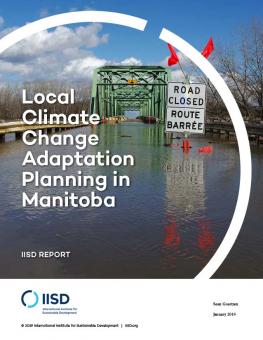
Local Climate Change Adaptation Planning in Manitoba
This study assesses the degree to which climate change adaptation is being considered in current local development plans, emergency plans and integrated watershed management plans in Manitoba.
The best available climate projections suggest that communities throughout Manitoba must prepare for significant climatic changes in the coming decades.
As part of these preparation efforts, municipalities should be considering the anticipated impacts of climate change in their key planning documents and identifying actions to reduce risks and adapt to these changes. To assess the extent to which Manitoba’s municipalities are preparing for climate change by incorporating climate risks and adaptation needs into local planning documents, the Climate Change and Air Quality Branch of Manitoba Sustainable Development commissioned the International Institute for Sustainable Development (IISD) to undertake this review.
The study reviewed a sample of local plans from across Manitoba, consisting of 20 development plans, five emergency plans and five integrated watershed management plans. Among the plans reviewed, it was found that five development plans, zero emergency plans and two integrated watershed management plans explicitly considered the need to adapt to climate change.
To address the gaps identified, this report recommends that the Province of Manitoba work with the Canadian Centre for Climate Services and the Prairie Climate Centre to help municipalities and watershed districts use local climate change projections to assess and mitigate risks. Climate change adaptation considerations should be incorporated into the templates for development plans, emergency plans, integrated watershed management plans, and any other relevant tools to provide municipalities and watershed districts with a helpful structure.
Further insights into municipal efforts to address climate change risks could be gained by examining a broader sample of local plans. Examining implementation tools such as zoning by-laws and annual budgets also could be useful to verify whether municipalities and watershed districts are acting on the content of their plan. A survey of local officials could offer insight into formal and informal aspects of climate change adaptation awareness, needs and efforts among Manitoba communities.
You might also be interested in
For Nature-Based Solutions to Be Effective, We Need to Work with Indigenous Peoples and Local Communities
Nature-based solutions have been praised as a promising approach to tackling the twin crises of climate change and biodiversity loss. But some Indigenous Peoples and local communities are questioning the legitimacy of the concept and what it symbolizes. It is time to listen to what they have to say.
How Can We Work With Nature to Tackle Drought and Desertification?
Drought is one of the most devastating and pervasive challenges exacerbated by climate change. However, we can work to reduce its effects through nature-based solutions for land restoration and climate-smart agriculture.
Canadian Youth Want to See Stronger Climate Policy in 2024
IISD takes a look at the Canada's Local Conference of Youth demands for policymakers after COP 28.
Powering the Clean Energy Transition: Net-Zero electricity in Canada
This brief explains how a shift to clean power generation can offer affordable, reliable electricity, benefiting households and businesses alike.